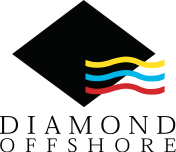Diamond Offshore Drilling
 | |
| Public company | |
| Traded as |
NYSE: DO S&P 500 Component |
| Industry | Petroleum industry |
| Headquarters | Houston, Texas, United States |
Key people |
James S. Tisch, Chairman Marc G. Edwards, President & CEO[1] |
| Products | Offshore Drilling |
| Revenue |
|
|
| |
|
| |
| Total assets |
|
| Total equity |
|
Number of employees | 3,400 (2015)[1] |
| Parent | Loews Corporation (52%) [2] |
| Website | www.diamondoffshore.com |
Diamond Offshore Drilling, Inc. is a deepwater drilling contractor. The company is headquartered in Houston, Texas, in the United States, and has major offices in Australia, Brazil, Mexico, Scotland, Singapore and Norway.[3]
Current operations
The company operates 33 drilling rigs including 24 semisubmersibles, 5 drillships, and 6 jackup rigs. [4]
The company provides quarterly online updates on the status of each rig in its fleet.[5]
In 2015, Petrobras accounted for 24% of the company's revenues. ExxonMobil and Anadarko Petroleum each accounted for 12% of the company's revenues.[1]
Operations outside of the United States accounted for 79% of the company's revenues.[1]
History
Diamond Offshore's beginnings can be traced back to the earliest days of the offshore drilling industry. Its predecessor companies were ODECO, Zapata Corporation, and Diamond M Drilling Co.
Diamond Offshore’s roots date back to May 1953, when Alden J. (Doc) Laborde founded Ocean Drilling and Exploration Co. (ODECO) in New Orleans. Laborde had designed what was probably the first submersible drilling rig. After finding a financial backer in Charlie Murphy of Murphy Oil Co., a grateful Laborde built the rig in 1954 and named the unit Mr. Charlie in honor of his benefactor. Today, the Mr. Charlie is a museum and training facility in Morgan City, Louisiana.
After noticing the stability of submersible rigs when they were only partially submerged for relocation, Laborde designed and constructed the first purpose-built semi-submersible rig, Ocean Driller, in 1964. ODECO rigs continued to rack up “firsts” in the industry in the 1970s, with Ocean Viking discovering the giant Ekofisk oil field for Phillips Petroleum Company in the North Sea and Ocean Victory discovering the Piper oilfield and Claymore field, also in the North Sea, for Occidental Petroleum.
In the early 1960s the onshore drilling company Brewster-Bartle went bankrupt. The banks that had become the owners of the company’s rigs contacted Don McMahon to take over the failed company. McMahon accepted the challenge and formed Diamond M Drilling Co. in 1964. He named the company after Diamond M Acres, his ranch near Simonton, Texas. McMahon took his company public in 1970 and expanded into offshore waters with the building and purchase of jack-up, barge, and semi-submersible rigs. In the early 1970s, Diamond M was one of the largest owners of barge rigs in the energy industry. The company continued to drill both on land and offshore. In the late 1970s, Western Oceanic tendered an offer to buy Diamond M. Unwilling to be purchased, Diamond sought and found a “white knight” in Kaneb Services, Inc.
In 1992, Diamond M Corporation purchased all of the outstanding stock of ODECO Drilling Inc. from ODECO Oil and Gas Co., a subsidiary of Murphy Oil. Shortly thereafter, Diamond M Corp. briefly changed its name to Diamond M-ODECO Drilling Inc. before becoming Diamond Offshore Drilling, Inc. in 1993. Diamond Offshore began trading on the New York Stock Exchange in October 1995 and acquired Arethusa (Offshore) Ltd. in April 1996.[6]
Recent financial struggles
Since 2012, the company has retired or sold 12 rigs and recorded over $1.0 billion in impairment charges.[1]
On February 8, 2016, the company discontinued payment of a quarterly cash dividend.[1]
Controversies
Worker asbestos exposure
In 1989, Diamond's predecessor bought six drilling rigs from the predecessor of Kaneb Management Co. LLC. Some of Kaneb's employees continued to work for Diamond after the transaction and then sued Diamond for personal injuries they allegedly suffered from asbestos exposure while they worked for Kaneb.[7] In a 2013 filing with the SEC, Diamond acknowledged that their equipment had been used for the "manufacture and use of asbestos-containing drilling mud," but sought to be indemnified from liability.[8]
References
- 1 2 3 4 5 6 7 8 9 10 11 Diamond Offshore Drilling, Inc. 2015 Form 10-K Annual Report
- ↑ "Diamond Offshore". Loews Corporation.
- ↑ Diamond Offshore: Locations
- ↑ Diamond Offshore: Fleet Overview
- ↑ Diamond Offshore: Fleet Status Report
- ↑ Diamond Offshore: Our History
- ↑ "Diamond Offshore Pulled Back Into Asbestos Liability Fight". Law360. June 11, 2013.
- ↑ Gibb, Gordon (October 1, 2013). "Offshore Drilling Giant Says "Not Guilty" in Drilling Mud Lawsuit". Lawyers and Settlements.